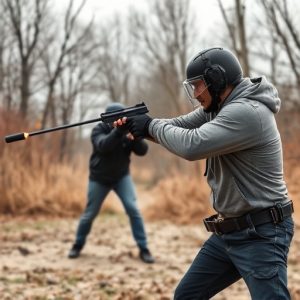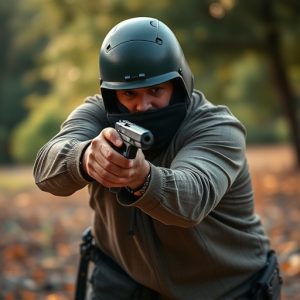Concealable Stun Guns for Women: Safety Features and Best Practices for Reliable Protection
Women carrying concealable stun guns for self-defense must understand potential misfire scenarios, s…….
Women carrying concealable stun guns for self-defense must understand potential misfire scenarios, such as battery issues and environmental factors, and prioritize regular maintenance. Key features like sensitive triggers, safety locks, and waterproof ratings ensure reliability in critical situations. The design, including ergonomic grip and robust mechanics, enables swift deployment while third-party certifications guarantee safety and effectiveness. Best practices involve proper training, regular device checks, keeping batteries charged, and awareness of environmental limitations for optimal self-defense.
“In today’s world, personal safety is paramount, especially for women seeking self-defense options. Concealable stun guns have emerged as a popular choice, offering a non-lethal way to deter attacks. However, understanding misfire prevention is crucial. This article delves into the mechanisms behind stun gun functionality, identifying common issues. We explore key features designed to prevent accidental discharges, ensuring reliable activation. Safety testing and certifications are also covered, along with best practices for carrying and using these devices, specifically tailored to meet the needs of women seeking empowerment.”
- Understanding Stun Gun Mechanism and Common Misfires
- Key Features for Preventing Stun Gun Misfires
- The Role of Design in Ensuring Reliable Activation
- Testing and Certification for Safety and Performance
- Best Practices for Carrying and Using Concealable Stun Guns for Women
Understanding Stun Gun Mechanism and Common Misfires

Stun guns, also known as electronic control devices (ECDs), work by delivering a high-voltage, low-current electric shock through two prongs or probes into the target’s body, disrupting their nervous system and causing temporary incapacitation. However, despite their reliability, stun guns can suffer from misfires due to various factors such as faulty battery connections, probe damage, or the presence of liquids on the contact points.
For women carrying concealable stun guns for self-defense, understanding these potential issues is crucial. Common misfire scenarios include situations where the device fails to activate when needed due to a dead battery or loose electrical connections. Additionally, bodily fluids like sweat or rain can interfere with the electrical signal, leading to a misfire. Recognizing these issues and ensuring proper maintenance, such as regular battery checks and keeping the stun gun dry, are essential for effective self-defense in emergencies.
Key Features for Preventing Stun Gun Misfires

When it comes to ensuring safety and reliability, key features prevent stun gun misfires, especially for concealable stun guns designed for women who need a discreet yet powerful self-defense tool. One crucial aspect is the trigger mechanism—a sensitive, precise design that requires minimal force to activate. This feature reduces the risk of accidental discharge, ideal for situations where speed and accuracy are paramount.
Additionally, advanced safety locks and mechanisms play a vital role in misfire prevention. These include tactical switches or levers that require a specific action or sequence to deploy, ensuring the stun gun is only activated when intended. Waterproof ratings and durable construction further enhance reliability, as these features protect against environmental factors that could compromise performance. For concealable stun guns for women, these preventive measures combine to offer peace of mind, empowering users with a dependable self-defense option.
The Role of Design in Ensuring Reliable Activation

The design of a stun gun plays a pivotal role in ensuring its reliable activation, especially for concealable stun guns intended for women’s self-defense. These devices are crafted to fit comfortably and discreetly in a user’s hand or concealed on their person, making them easily accessible during an emergency. The ergonomic grip and compact size should not compromise the weapon’s effectiveness; instead, they must enhance it. Designers achieve this by incorporating features like textured surfaces for a secure grasp, even when wet or under duress, and triggering mechanisms that require minimal force to activate. Such attention to detail ensures users can deploy the stun gun swiftly and accurately when needed.
Furthermore, the internal mechanics of the device are crucial. Reliable activation depends on robust springs, precise contacts, and high-quality electrical components that work in harmony. Testing these elements under various conditions ensures consistent performance. For instance, a well-designed stun gun should continue to fire even after being dropped or exposed to extreme temperatures, making it a reliable companion for women who carry them for personal safety.
Testing and Certification for Safety and Performance

When considering a concealable stun gun for personal safety, especially for women, one of the most critical aspects to evaluate is its testing and certification. Reputable manufacturers subject their products to rigorous safety standards and performance tests to ensure they meet industry requirements. These include evaluations for electrical output, contact closure, and endurance, among other factors. Independent third-party certifications like UL (Underwriters Laboratories) or similar organizations guarantee that the stun gun functions as intended under various conditions, providing users with peace of mind.
Proper testing not only guarantees the effectiveness of the stun gun but also highlights safety features designed to prevent misfires. These might include mechanical safeguards, sensitive triggers, and electronic circuits that prevent accidental activation. For women carrying concealable stun guns for self-defense, understanding these safety mechanisms is vital, ensuring the device will respond when needed while minimizing the risk of unintended discharge.
Best Practices for Carrying and Using Concealable Stun Guns for Women

When carrying a concealable stun gun, women should prioritize safety and familiarize themselves with best practices. Opting for a compact, easily concealable design is essential, ensuring it fits discreetly in a purse or pocket. Regular training is vital; practicing deployment techniques allows for quick and confident usage in an emergency. Understanding the device’s range and activation mechanisms is crucial. Women should also maintain their stun gun in optimal condition, regularly testing batteries and checking for any signs of damage or malfunction.
For effective self-defense, it’s recommended to keep the stun gun within easy reach and ensure it is clearly visible when needed. Additionally, carrying extra batteries and knowing how to replace them swiftly can be a game-changer. Women should also consider environmental factors; for instance, using a stun gun in wet conditions may reduce its effectiveness, so being aware of these limitations is key to responsible self-defense.
Stun guns, particularly concealable models designed for women’s personal safety, must be reliable and safe. By understanding the mechanisms behind misfires and adopting key prevention features, users can enhance their self-defense capabilities. Design innovations play a crucial role in ensuring consistent activation, while rigorous testing and certification guarantee performance and safety. Following best practices for carrying and using these devices empowers women to protect themselves effectively in today’s digital era.


